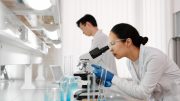As the number and proportion of older people in the global population grows, the notion of healthy longevity is commanding attention. Dr Tatiana Sergeenko from Sagentia Innovation says medtech will be a key enabler of advancement in this space.
According to World Health Organization figures, 22% of the world population (2.1 billion people) will be aged 60 and older by 2050. Of this, 426 million will be aged 80 or over. Aging populations present significant challenges for healthcare systems, so helping people stay healthier for longer will be paramount. In support of this, healthy longevity is set to become one of the major health categories over the next decade.
With medical care pathways shifting from reactive to proactive and preventive care, healthy longevity will centre around earlier detection and better prediction of age-related diseases, novel geroprotective therapies to tackle their root causes, and self-care. Medtech will play a critical role across the entire spectrum.
Understanding and controlling the rate of aging
Aging research has advanced significantly in recent years, particularly with the discovery that the rate of aging can be, to some extent, controlled. This creates opportunities for new developments encompassing everything from diagnostic technologies – such as multi-omics approaches for early diagnosis and pre-diagnosis of diseases – to treatment solutions, including genetic, pharmaceutical, and nutritional interventions.
One area that offers great potential is the identification and potential closure of gaps between chronological and biological age. Population statistics generally focus on chronological age (the number of years someone has been alive). However, scientists are more interested in the rate at which a person ages physically, known as biological aging. Although chronological age does reflect disease risk, the rate of aging varies across individuals, organs, tissues, and clinical conditions. Chronological age does not capture this variation well. On the other hand, when a person’s biological age far exceeds their chronological age, it may indicate more susceptibility to age-related health conditions.
There is a lack of consensus on how biological aging processes might be precisely measured and analysed for the prediction or early detection of aging-related diseases. However, in 2013, a team of biochemists and molecular biologists defined nine hallmarks of aging that contribute to the deterioration and dysfunction of cells as they age (genomic instability, telomere attrition, epigenetic alterations, loss of proteostasis, deregulated nutrient-sensing, mitochondrial dysfunction, cellular senescence, stem cell exhaustion, and altered intercellular communication).
Each hallmark indicates biological aspects of age-related deterioration. They influence one another and operate in a large and tightly connected network, suggesting a holistic approach to anti-aging interventions might be beneficial.
Driving progress
At present, commercial activity for healthy longevity is focused on closing the gap between chronological and biological age and broadly encompasses three categories:
- Diagnostics (e.g., wearable devices, test kits, apps for measuring, tracking, and quantifying biomarkers for biological age assessment/prediction)
- Formulated treatment solutions (e.g., drugs, functional supplements, nutritional support)
- Recommendations for self-care (e.g., lifestyle guidance).
Ongoing developments indicate that future solutions will go beyond the treatment of age-related diseases to potentially restore lost function and prevent age-related diseases. We’re seeing exciting advancements in digital and formulated interventions, validation of biomarkers of aging, and use of data analytics which will break new ground.
Three areas in particular hold great potential: geroprotective intervention, biomarkers for the assessment of biological age, and advanced data-led approaches rooted in machine learning (ML) and artificial intelligence (AI).
Geroprotective interventions
Interesting early-stage research concerning geroprotective interventions includes the application of CRISPR/cas gene editing for diagnosis and correction of genetic abnormalities, the use of liquid and virtual biopsy, in-situ diagnostics, and advances in regenerative medicine and organ bioengineering.
Current development of geroprotective therapies includes the design of individual medicines and ‘chemical cocktails’ which selectively target hallmarks of aging to repair the damage that accumulates in our bodies long before symptoms manifest.
During 2023, several studies with positive implications for healthy longevity captured the attention of scientific and mainstream media. These include findings surrounding six chemical cocktails to induce reprogramming to reverse cellular aging published by a team of Harvard researchers. This indicates that rejuvenation by age reversal could be achieved not only by genetic means but also by chemical means.
Separately, a Columbia University study found that amounts of the semi-essential amino acid taurine in circulation decreased with age and showed that supplementation with taurine slowed some key markers of aging such as increased DNA damage, telomerase deficiency, impaired mitochondrial function, and cellular senescence, and improved lifespan in mice and health span in monkeys.
Biomarkers for assessment of biological age
Research for biomarkers to quantify biological aging and predict aging-related outcomes has intensified in recent years. Wearable devices, test kits and apps are being developed to measure the rate at which a person ages physically through the examination of physiological characteristics of aging.
More advanced solutions go beyond the delivery of interesting data to generate actionable insights. However, harnessing, integrating, and analysing vast quantities of biomarker data to develop and validate solutions for healthy longevity is not easy. The ability to derive biological age predictions and draw meaningful, actionable insights from biomarker data requires sophisticated analytical tools.
Harnessing data-led approaches
ML and AI techniques and algorithms are increasingly used in healthy longevity research surrounding the development of reliable metrics of aging, biological age assessment, and the effectiveness of geroprotective medications. ML/AI-enabled systems can also be used to regulate behaviour and psychological elements of age-related conditions, determining the most relevant treatment options for an individual based on their personal biomarkers and lifestyle preferences.
Opportunities for the medical sector
The healthy longevity landscape is vast, and the science is moving at pace. Preventive medicine is a critical component of this movement, and it will be facilitated by earlier detection, faster diagnosis, and better prediction of health issues to maximise healthy longevity. In the coming years, the shift from reactive to proactive healthcare is set to accelerate, benefiting individuals and healthcare systems alike.
Deepening understanding of aging processes creates a fertile landscape for medtech and pharma companies. Accelerated innovation in next-generation molecular-level diagnostics, geroprotective therapies and advanced data analytics for better prediction of age-related diseases and assessment of the effectiveness of treatment solutions, augments the opportunity. Organisations that leverage relevant technologies effectively to make early inroads to healthy longevity have much to gain.
Focusing on aspects of health and aging that are easy to monitor may be a good place to start. However, specific opportunities and priorities are likely to vary across international markets.
People age differently, in highly complex ways, meaning there is much scope for personalised approaches to healthy longevity. The healthy longevity market is largely based on this principle and medical developments need to push at the boundaries of possibility. Continued research and innovation, with outcomes translated into commercial offerings, will drive improved health for more people in older age.
By Dr Tatiana Sergeenko, Principal Consultant, Life Sciences, at Sagentia Innovation





